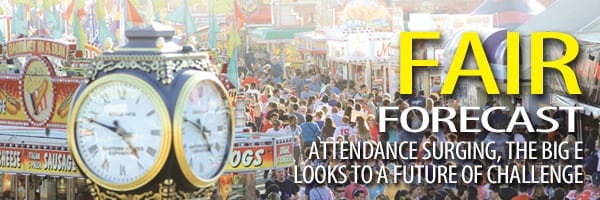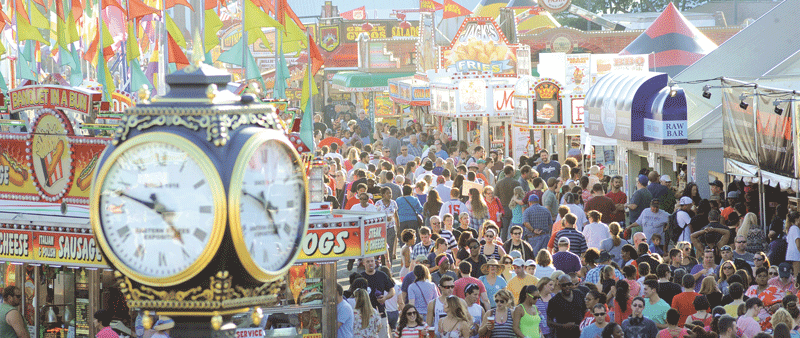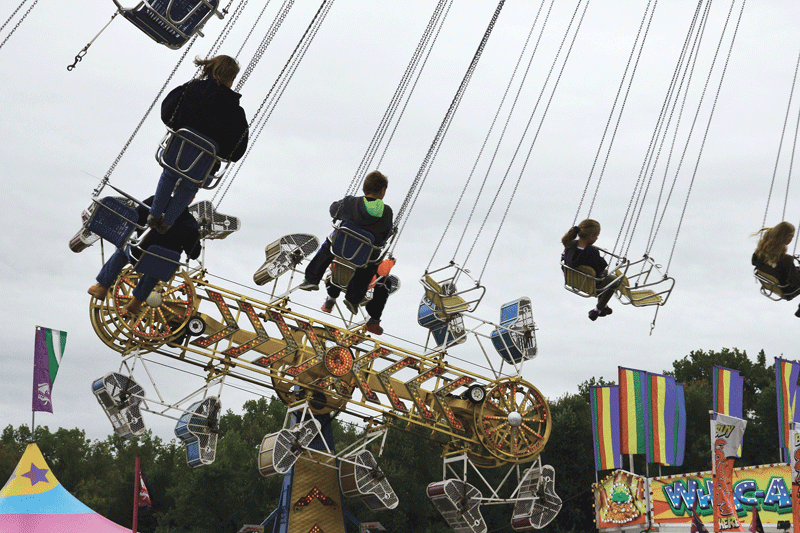
Attendance Surging, the Big E Looks to the Future
Fair Forecast

Since taking over as CEO of the Eastern States Exposition in 2012, Gene Cassidy has overseen record-setting attendance during the 17-day Big E fair and a robust series of year-round events that, together, generate nearly a half-billion dollars in economic impact. But that success is no fluke; it’s a result of year-round work and the ability to plan years down the road. That road will soon bring several challenges, from increased competition for dollars (notably from a Springfield casino) to a very worrisome highway reconstruction. But with a century of history behind it, the Big E seems poised for a promising future.
Gene Cassidy buys groceries just like everyone else, but he doesn’t look forward to it.
“I’ve said this before: There are very few places to work, places you can establish yourself as a professional, where your patrons look forward to supporting you,” said Cassidy, CEO of the Eastern States Exposition (ESE). “Don D’Amour [CEO of Big Y] is a good friend of mine, but, as much as I like Don, I hate grocery shopping. But people want to come to the fair. So we have to work 24/7/365 to make sure this stays relevant in people’s minds and they come to support us.”
That year-round effort — which is intensifying this month as the Big E, the ESE’s flagship, 17-day agricultural fair, prepares to open on Sept. 18 — has resulted in record-setting attendance figures every year since Cassidy, who has been with Eastern States since 1993, took the reins from Wayne McCary in 2012.

Gene Cassidy says record-setting attendance for the past three fairs is a result of year-round planning.
And they do, he continued. But it’s fun with a purpose.
“We’re geared toward families and geared toward fun, but we have a mission,” Cassidy told BusinessWest. “We are stewards of a nonprofit organization that’s charged with the promotion of agriculture and industry for the six New England states.”
Cassidy reveres the fair’s founder, Joshua L. Brooks, an industrialist so concerned that agriculture was losing ground in New England at the turn of the last century — with so much being produced out of the Midwest and South Central states — that he persuaded the National Dairy Show to move its annual event from Chicago to West Springfield in 1916, christening the new event the Eastern States Agricultural and Industrial Exposition.
“That name was so cumbersome that, in 1923, Mr. Brooks shortened it to Eastern States Exposition,” Cassidy said. “But he was an industrialist; he wanted to make sure we pay attention to industry in our region, and that’s something that’s easily lost in translation to the average fair patron. Even residents of West Springfield may not associate Eastern States with industry, but we play a significant role in supporting educational endeavors to that end.”
As treasurer of the Regional Employment Board of Hampden County (REB), Cassidy has long been involved in efforts to meet the workforce needs of area industries by supporting education and training programs. “We need to make sure we have the resources to keep building a workforce for the future.”
He noted that trades aren’t taught in high schools like they were 25 years ago, having been replaced by an emphasis on preparing students for a liberal-arts education in college, and that shift has contributed to a skills gap area companies grapple with today.

From Maine lobster to Rhode Island chowder to anything that can possibly be deep-fried, the Big E offers food for every taste.From Maine lobster to Rhode Island chowder
The Big E has long played a role in raising awareness of industry in the region, but that has become an increasingly difficult task.
“We’ve struggled with that,” Cassidy said. “There was a time at the fair when there were more elements of industry; we had big trucks and combines, machine-tooling equipment on display. In this age, there are now trade shows that satisfy those specific markets, and they advertise on the Internet.”
Years ago, he explained, companies like Westinghouse and General Electric would introduce new products at the Big E, and Nash Motors would put brand-new models on display. “In this contemporary age, fairs don’t fill that need anymore; there are other means by which companies communicate with customers.”
To fill that gap, Cassidy and his team bring as many niche trade shows as possible to the fairgrounds throughout the year, but the Big E itself has had to evolve past its industry-centric roots. No worries, though — there’s still plenty on tap.
Farm System
Agriculture, for instance.
“The lion’s share of our revenue goes to supporting best practices in agriculture production,” Cassidy told BusinessWest, and it’s an effort that extends throughout the year.
“Because of the way agriculture has changed over the past 100 years, our reach goes way beyond New England,” he added. “Last week, we had a youth sheep show that attracted people from 20 states, including Michigan, Missouri, and Oklahoma.
“Our agriculture schedule takes place all year,” he went on. “Obviously, it’s very important for us, as it was to our founder. We play a material role in subsidizing the horse-show industry. Two of the oldest horse shows in the country are produced during our fair. It’s historically important — a part of our DNA.”
But Cassidy admitted that plenty of people attend the Big E for the wide array of food.
“We’re always searching for new food products, and that search goes on every day,” he said, noting that the recent food-truck festival held on the fairgrounds — which featured 41 trucks and attracted almost 30,000 attendees, double the expected turnout — reflects how important food offerings are to the success of the fair. “And nowadays, the food trailers have incredible technology; they can cook virtually anything.”
Still, he added, “it’s not easy to get into the Big E. We’re very, very concerned about people’s health. We work very closely with the town of West Springfield’s health inspector, and we also have an independent health inspector on our own payroll to make sure the food products are second to none,” he said, noting that, for example, all frying oil must be changed daily, where restaurants might reuse a batch for two or three days.
In a time when an incident can spread across social media with viral speed, the Big E takes its reputation seriously.
“Food safety is extremely important to all of us,” he added. “All you need is one person to get sick, and that’s the end of you. You’ve got to be diligent with refrigeration. It’s not inexpensive to be a food purveyor on the fairgrounds because we insist on high standards.”
The animal shows and competitions also feature much more behind the scenes than patrons realize, he added.
“We have very high ethical standards on our agricultural programming; in fact, the code of ethics at Eastern States has been copied by other agricultural entities across the country. If you’re competing at that level, people will drug their cattle, so we have to do a lot of animal testing. Just like with steroids in baseball, we make sure they’re not chemically tampered with.
“We take that stuff seriously,” he went on. “Just this week, the headlines in the agriculture industry were that all the people showing cattle at the Indiana State Fair last year were stripped of their ribbons after it was determined there was some drugging going on. We wouldn’t want our cattle show to be compromised. That’s our frontline reputation, same as if someone got sick with salmonella at a food stand.”
This year has brought another threat — breakouts of avian flu, which is lethal to poultry.
“The avian flu is a big issue for us. That’s why this is the first year in maybe 60 years we won’t have a chick hatchery,” Cassidy explained. “We just can’t take a chance of contributing to the spread. It doesn’t harm humans, but we don’t want to take any chance of spreading avain flu to other birds.
“People won’t like that,” he said regarding the hatchery closing. “They do look forward to it. But we’ll have an exhibit about poultry, educating people about avian flu.”
Music, Music, Music
Musical entertainment has been a staple of the Big E for generations. But every year, Cassidy noted, it has become more expensive to book top acts, so several years ago, the Big E started charging for a top musical act or two while charging fair attendees nothing for the rest.
“You have to budget for a profit so you can pay your bills, but you have to invest in your product so people can enjoy their experience. We give away a lot of entertainment, so that everyone can participate at no extra cost,” he said, noting that this year’s live concerts include Kansas, Ace Frehley, Bridgit Mendler, the Charlie Daniels Band, Southside Johnny & the Asbury Jukes, Anita Ward, and about a dozen more, including a visit from DJ Paris Hilton, who, it turns out, enjoys spinning records when she’s not earning tens of millions annually in the fashion world.“Now, as we speak, in the early weeks of August, we’re really focused on 2016,” Cassidy said, adding that John Juliano, the Big E’s long-time special-events director, is already working on securing entertainment contracts for next fall. “He’s constantly building his contact network so we’re able to attract good-quality talent. So much of our ability to promote ourselves is connected to these big names.”
He added that the Big E has a strong reputation in the entertainment industry for managing talent, which is critical. “We make it so these people have a great experience here, so we can attract the next batch. And we have to be really good at it, because we’re competing in a very difficult marketplace.”
It’s a constant battle, he went on. “Within three days of the fair closing down, John is in Nashville, meeting with talent agents, and the management team from Eastern States will be fully engaged, out at national conventions, looking for exhibitors and vendors. It’s a lot of fun, but it’s a lot of work. You have to get 2016 booked up; if you don’t have everyone lined up by May 1, you’re in trouble.”
There’s plenty at stake when planning a successful fair, he noted. According to a report the ESE produced last year, the 17-day Big E, plus all the other events that take place on the fairgrounds each year — which feature exhibitions for animal lovers, car enthusiasts, gun owners, campers, and dozens of other groups — benefit the region with an annual economic impact of $479 million.
The tax revenues alone include $3 million in income tax, $1.4 million in sales tax, $427,000 in hotel tax, and $3.3 million in food and beverage tax. More significantly, events generate $299 million in gross regional product and account for 3,000 jobs in Hampden County that generate $91.9 million in personal income. The exposition’s impact on the rest of New England and New York include 2,000 jobs generating $134 million in personal income. In all, 2.5 million visitors stop by the fairgrounds each year, well over 1 million for the Big E alone.
“A lot of my time is dedicated to discovering more non-fair events, trying to draw people to the region year-round with trade shows and other stuff,” he said. “It’s a means by which to promote the region, get more people here to our hotels, drive people to our airports, and create a mechanism for commerce.”
Home Stretch
Of course, most of the staff’s attention is acutely tuned to the Big E — everything from the big picture to the smallest details.
“We’re making sure the fairgrounds are tuned up,” Cassidy said. “Everything has to be tested — door locks, fire suppression, make sure the drains are clear. We do a lot of maintenance during the year, but this is the time everything gets tested.
“If we didn’t start setting up the fair until very late, we’d have way too many people working way too many hours, and mistakes would happen,” he added. “So, right now, we’re a steam locomotive going downhill.”
That preparation mingles with a healthy dose of hope — mostly for favorable weather, as a weekend of steady rain can wreak havoc with revenues. But weather isn’t the only challenge. As Cassidy mentioned, the entertainment market has been crowded in recent decades by the two Connecticut casinos (and more to come in Massachusetts, including MGM Springfield right across the river in 2017), civic centers, and other venues.

The annual fair also provides a showcase for local talent from schools and clubs.
That casino might not open until 2018, however, thanks to a major highway reconstruction project that will shut down a portion of I-91 in downtown Springfield for more than two years.
“The highway job scares the hell out of me; it really, really does,” Cassidy said. “This could extend beyond two fairs, and it’s something we have very serious concerns about. Frankly, everyone in the region who is in business needs their awareness raised about this. Once it’s done, it will be a marvelous thing, a terrific improvement. But between now and then, it’s going to tax businesses — and the ability of facilities such as ours to attract people.”
But, when it comes to such challenges, he’s accustomed to planning ahead, because that’s how a century-old institution remains vital in the public’s mind.
“In a 100-year-old organization, I have to be thinking 25 years out,” he said. “This place has got to be as relevant in 2040 as it is in 2015. Mr. Brooks, when he conceived of this place, he was thinking way into the future.”
The fairgrounds have seen plenty of change; Cassidy recalled how the site was once an ice-hockey mecca before the rink was eliminated in 1992. And he showed BusinessWest detailed plans for how the Big E grounds might have been used for several Olympic events in 2024, including cycling and cross-country — plans that are now defunct, obviously, since Boston is no longer competing to host those Games. But the effort demonstrates how Eastern States Exposition leaders need to think outside the box to remain relevant in the next 100 years.
“We have a responsibility to families to maintain ourselves as a place that provides a family environment an outlet for socializing and learning about agriculture and industry, and I think those things won’t change; those are staples of American society,” he said. “There’s a sense of community at Eastern States, and fewer and fewer places have that sense.”
Joseph Bednar can be reached at [email protected]






